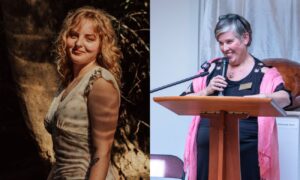By Grant Utter
Earlier this summer, Oglethorpe alum Ella Newbern ’24 and Director of the Oglethorpe University Museum of Art (OUMA) Elizabeth Peterson Jennings presented a case study on art and accessibility at the annual Association of Academic Museums and Galleries virtual conference—a prominent event for museum leaders and professionals across the country.
In their presentation, the staff and alumni pair underscored the importance of inclusivity in museums. Institutions like Oglethorpe’s teaching museum are meant to build community through art appreciation and education, so it is important that they also do their best to make everyone feel welcome.
“Accessibility and disability activism are so important to ensuring that all people are welcome to a conversation and space,” says Newbern. “Being able to emphasize accessibility to so many people of different organizations was very empowering and gave me hope for the future of accessibility in art events.”
In their presentation, Peterson Jennings and Newbern highlighted a recent OUMA event to demonstrate the positive effects of accessibility.

A dancer invites a crowd to lift up their hands during a performance in the Oglethorpe University Museum of Art’s Skylight Gallery
In 2022, the museum hosted its first-ever celebration of Deaf and disabled people. The event was hugely popular—guests packed the museum’s Skylight Gallery as dancers, artists and musicians gave moving performances that illustrated the joys and pains of living with disability. The event proved that small museums can make a big impact and that intention matters when building a community.
This celebration was developed through community effort, too. The event was produced by Disabled & Neurodivergent Students of Oglethorpe, a new student organization that Newbern had co-founded earlier that summer, and The Ikouii Creative, a national organization that helps cultural institutions design experiences with accessibility in mind and provides support for artists living with disabilities worldwide. The organization’s founder, Aleatha Lindsay, joined Peterson Jennings and Newbern to present on the celebration’s impact.
That event was just the beginning of the museum’s efforts to champion accessibility in all its practices—an effort the museum has dubbed “Art for All.”
“‘Art for All’ means we pledge to be flexible and adaptable to root out biases, and in this instance, ableism,” says Peterson Jennings. “If we really do this right, it means anyone who enters the museum feels welcomed and a sense of belonging. It also means that if they don’t feel that, we respond sensitively and thoughtfully with a promise to improve.”

Ella Newbern ’24 (left) and Director of the Oglethorpe University Museum of Art Elizabeth Peterson Jennings (right)
That promise to improve was the thesis of Peterson Jennings and Newbern’s presentation. They emphasized that accessibility is not a one-and-done project; it requires constant vigilance and stewardship, and museums owe it to their communities to put in that work.
A new exhibit with Ikouii celebrating Deaf and disabled artists, “The Gaze,” is on view at the museum beginning July 12. The exhibit begins a year-long celebration of Deaf and disabled artists at Oglethorpe’s museum. Two more exhibitions platforming such artists will headline, including another collaboration with Ikouii, “Feel the Music: Deaf Creatives in OUMA” in September and “Fragile Genius: The Art of Anna Catherine Wiley and Buford Delaney” in January 2025.

